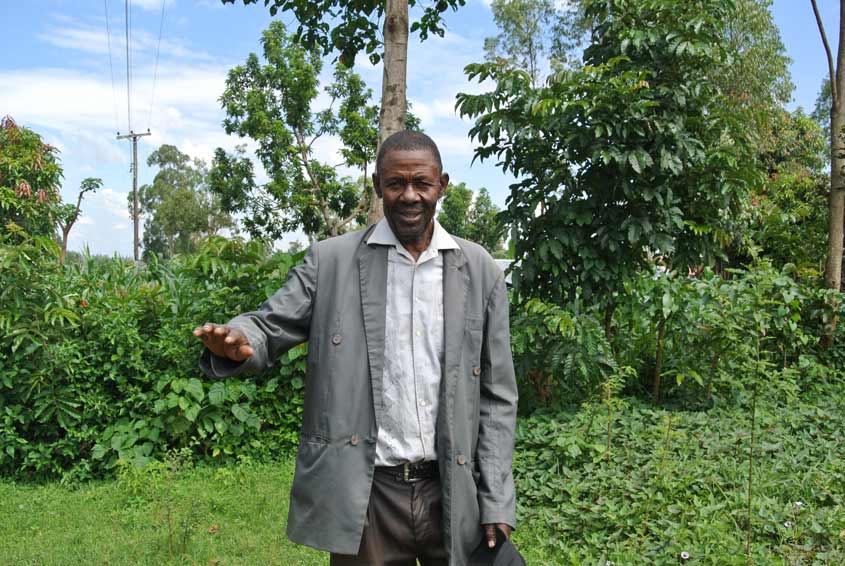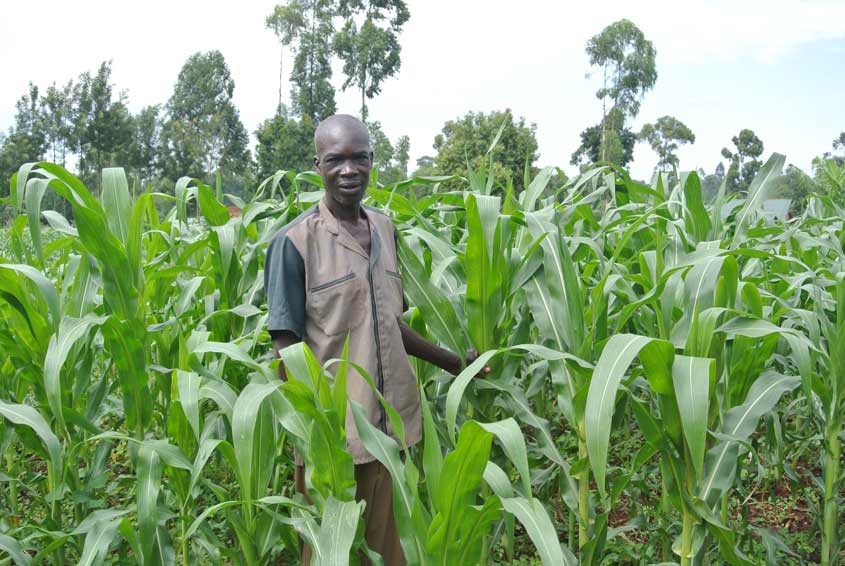
Kenyans turn to drought-tolerant maize variety to fight poverty
By Evelyn Situma, Communications Officer, African Agricultural Technology Foundation (AATF)
Maize farming was becoming a source of major frustration for 61-year-old Jotham Apamo. Despite his best efforts, his small quarter-acre farm yielded just 10 kilograms of maize each harvest, and then only if he was lucky and there were no pests or drought.
“There was hardly any gain for me. I was pushed into debt. I couldn’t feed my family or pay school fees for my children,” he recalls.
Mr. Apamo’s attempts to switch to higher-yielding maize varieties did little to improve the situation. After seven fruitless years he was on the point of giving up when he learned about a new hybrid seed called DroughtTEGO®.

“I got to know about DroughtTEGO® maize through a local nonprofit organization called Rural Outreach Programme (ROP). They offered to do a demonstration on my field in 2014,” he explains. Curious, Mr. Apamo willingly agreed to set aside a portion of his farm for the trial. Could these seeds change his fortunes?
At harvest time all his hopes came true. “I was truly amazed. I harvested 110 kilograms from the tiny demonstration plot of 0.025 acres,” he says with a wide grin. Inspired by these results, the following year he planted TEGO maize on half an acre. The outcome was equally encouraging.
“I have come to realize that DroughtTEGO® is a quality seed. It can withstand drought and strong wind,” says Mr. Apamo. Even when termites threatened to damage his second-season (short rainy season) crop in 2015, he still harvested nine bags of maize each weighing 90 kilograms from the half-acre of land – a total of 810 kilograms, just two bags less than his 2014 harvest. “I can now feed and educate my family,” he says.
About DroughtTEGO®
DroughtTEGO® is a drought-tolerant white maize variety developed and deployed by the Water Efficient Maize for Africa (WEMA) Project coordinated by the African Agricultural Technology Foundation (AATF). This climate-smart variety can produce a substantial grain yield even under moderate drought conditions.
Sylvester Oikeh, WEMA project manager, says that under moderate drought conditions, WEMA’s drought-tolerant maize can increase yields by 20 to 35 percent compared with varieties developed in 2008 when the project started.
WEMA has developed more than 80 drought-tolerant (climate-smart) maize varieties adapted to the prevailing weather conditions and diseases of different regions. In 2016, the WE2109 variety was launched in Tanzania, and WE3127 and WE3128 hybrids were released in South Africa.
DroughtTEGO® produces high yields even in tough conditions, with average yields of 4.5 tons per hectare compared to local varieties which yield around 1.8 tons per hectare. Little surprise, then, that DroughtTEGO® maize is becoming a popular choice among smallholder farmers in western Kenya.
Mr. Apamo has already convinced 20 other local farmers to plant TEGO maize. Having seen the benefits of using the seed with their own eyes – higher yields, better living standards – they were easily persuaded.
One of his neighbors, Grace Omulanda, who began planting TEGO maize in 2015, has also inspired 40 other women farmers in the Joywo Women’s Group to follow suit.

True to its name – “TEGO” means “to protect” in Latin – the varieties are helping to fight poverty and to protect the livelihoods of smallholders in Kenya and beyond.
About WEMA
WEMA is a public–private partnership launched by the AATF in 2008 with financial support from the Bill and Melinda Gates Foundation, the United States Agency for International Development (USAID) and the Howard G. Buffett Foundation. Its aim is to develop and deploy drought-tolerant and insect/pest-protected (climate-smart) technologies to farmers in Sub-Saharan Africa.
WEMA uses the expertise and support of the US-based agrochemical and agricultural biotechnology corporation Monsanto Company, the International Maize and Wheat Improvement Center (CIMMYT) in Mexico, and national agricultural research systems of Kenya, Mozambique, South Africa, Uganda and the United Republic of Tanzania. Community-based farmers groups and local nonprofit organizations help distribute WEMA products to farmers and encourage their use. Maize is a staple food in Kenya, and many smallholder farmers have proven highly receptive to adopting new higher-yielding and resilient varieties.
Reaching out to farmers at the grassroots
The AATF is partnering with grassroots organizations to promote WEMA maize hybrids among farmers.
“Farmer-based organizations have done good work in offering their support to farmers. We thank them for their considerable efforts and acknowledge that it is very difficult for the government to achieve such success on its own,” said Titus Muganda, Senior Assistant Chief of West Butsotso, speaking at a meeting of farmers in the nearby town of Kakamega in western Kenya.
“It is through farming technologies such as TEGO that we will be able to fight poverty and hunger,” Wycliffe Kombo, Chief of North Butsotso, told farmers during a field day. “Blue-collar jobs are fading away and farming is what we are left with.”
In December 2015, the Rural Outreach Program of western Kenya held a series of field days to introduce DroughtTEGO® varieties to farmers in the region. These were very popular events attracting over 1,000 people, including many government officials.

“I am delighted that TEGO has transformed farmers’ lives. ROP is stopping at nothing to spread the good news,” says Doris Anjawa, ROP Coordinator in western Kenya.
After just two seasons of planting TEGO in western Kenya, she has seen a transformation in the fortunes of local farmers. Her father was able to build a new house with proceeds from his TEGO harvest. Others have been able to extend their homes in the same way.
Through its outreach partners, WEMA is continuing to organize field trials with farmers in the five project countries – Kenya, Mozambique, South Africa, Uganda and the United Republic of Tanzania – to create awareness and uptake of this life-changing technology.
“I knew maize as any other grain, but now I am mindful that there are new high-yielding varieties I can farm,” says Grace Omulanda.
Thanks to these types of outreach initiatives, the demand for TEGO maize has shot up since 2015, when farmers began ordering the maize from agricultural suppliers.
As a consequence, a growing number of seed companies are licensing the seed from WEMA to supply local markets. The project has made 21 inbred lines available to seed companies for license, and so far seven seed companies in Kenya, including Elgon Kenya Ltd, Olerai Seeds Ltd and Ultravetis East Africa Ltd, are selling DroughtTEGO® maize to farmers.
“The WEMA project has successfully established the biggest maize-breeding pipeline in Africa. There were 17,269 hybrids and over 19,000 parental lines under various stages of development and testing in 2015 across five WEMA Project countries,” notes Sylvester Oikeh.
The economic importance of agriculture in Kenya
Kenya’s agricultural sector accounts for 24 percent of the country’s GDP, but all too often, poor agronomic practices, use of low-yielding varieties, drought, pest and disease result in poor yields, with the country falling short of its full agricultural potential.
The 2016 Economic Survey by the Kenya National Bureau of Statistics shows a nine percent annual rise in national maize production, from 39.0 million bags in 2014 to 42.5 million bags in 2015 against a total consumption of 48 million bags. The shortfall was made up by informal cross-border trade between Kenya and Uganda, according to data from the 2015 Economic Survey.
Only by adopting good farming practices and facilitating access to and uptake of new high-yielding, drought- and disease-resistant varieties will it be possible to boost productivity and incomes and sustain the livelihoods of farmers in Kenya and beyond. High-yielding, drought-tolerant maize varieties like TEGO are part of that solution. That is why the WEMA deployment team is busy liaising with seed companies to ensure that the WEMA drought-tolerant varieties are available for more and more farmers to benefit from the technology and improve their livelihoods.
The WIPO Magazine is intended to help broaden public understanding of intellectual property and of WIPO’s work, and is not an official document of WIPO. The designations employed and the presentation of material throughout this publication do not imply the expression of any opinion whatsoever on the part of WIPO concerning the legal status of any country, territory or area or of its authorities, or concerning the delimitation of its frontiers or boundaries. This publication is not intended to reflect the views of the Member States or the WIPO Secretariat. The mention of specific companies or products of manufacturers does not imply that they are endorsed or recommended by WIPO in preference to others of a similar nature that are not mentioned.